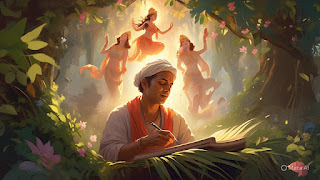When Poetry Meets Divinity: Rupa Goswami’s Legacy
There are scriptures that command the mind.
There are philosophies that challenge the intellect.
But rarely do we find words that sing to the soul.
Rupa Goswami’s legacy is that rare melody—where
poetry is not merely ornamental, but instrumental in revealing the deepest
truths of divine love. His writings are not just literature; they are portals
into rasika spirituality, drenched in bhakti and beyond logic.
To understand Rupa Goswami is to accept that the
Divine doesn’t always shout from the mountaintop—it whispers through a verse,
sighs through a metaphor, and dances in the pauses of a song.
Poetry as Bhakti Yoga
In Rupa Goswami's world, every syllable is sacred.
His poetry isn't just written—it’s worshipped. Through verses in Stavamala,
Ujjvala-nilamani, and Bhakti-rasamrita-sindhu, he stitched the
heartbeats of Radha and Krishna into linguistic embroidery. His aim wasn’t to
explain God. His aim was to dissolve the “I” that seeks explanation.
For Rupa, bhakti wasn’t a belief system—it was an aesthetic
surrender. His verses didn't teach devotion—they caused devotion.
Each composition was a mirror reflecting the soul’s longing to be absorbed into
the divine rasa.
The Divergent Bridge: Language as Love
In a world where spirituality is often reduced to
rigid rules and intellectual frameworks, Rupa Goswami shattered the divide
between beauty and truth. He offered an incomparable bridge: poetry as prasad,
meter as mantra, and metaphor as meeting point between jiva and Krishna.
He didn’t preach. He sang.
He didn’t instruct. He invoked.
He didn’t teach love. He translated it into rhythm.
His work is the quiet revolution where Sanskrit
meters were tuned to the pitch of the heart’s yearning.
Why This Matters Today
Modern seekers often hunt for the Divine in silence,
detachment, or philosophical detours. Rupa Goswami reminds us: God isn’t hiding
behind complexity. Sometimes, He dances openly in couplets.
In a noisy world, his poetry offers sacred
stillness. In a heart full of doubt, his metaphors offer melted answers. And in
an age of spiritual fatigue, he reawakens the sheer joy of feeling God.
The Devotional Toolkit: Living Rupa’s
Rasika Rasa
Here’s how to let his poetic bhakti infuse your
daily life:
🌼
Daily Rasika Verse
Start your day by reading one verse from Stavamala or Bhakti-rasamrita-sindhu.
Don’t analyze—immerse. Read it aloud. Let the sounds touch your breath.
🪕
Metaphor Meditation
Take one metaphor from Rupa’s work (e.g., “Krishna’s smile is a moon rising in
the ocean of Radha’s heart”) and meditate on it for 5 minutes. Visualize it.
Feel it emotionally.
🖋️
Devotion Doodles
Write a four-line verse each morning dedicated to your own experience of divinity.
Don’t worry about rhyme or rules—just let your bhakti bleed through your ink.
🎵
Chant with Cadence
Choose a shloka of Rupa and sing it like a lullaby. No perfection needed. Let
the vibration echo within your body temple.
🌸
Poetry Altar
Create a small sacred space with your favourite verses, images of
Radha-Krishna, and offerings. This becomes a “poetic portal” to reconnect when
the day feels mundane.
Rupa Goswami didn’t just write poetry.
He handed us the flute.
And whispered, “Now sing your soul into the heart of God.”



Comments
Post a Comment